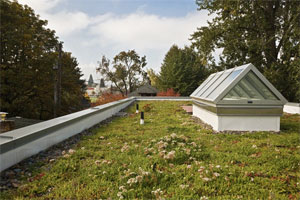As the construction industry begins to dust itself off after a doozy of a recession, a recent study shows that green building has been a real bright spot in the relative gloom.
In his Inhabitat.com blog post entitled “Green Buildings on the Rise Despite Recession,” Timon Singh covers the recent release of a major study by McGraw Hill Construction that demonstrates that not only are US homes getting greener, but the demand for green buildings, and builders’ activity to meet that demand, is increasing.
 This certainly matches our experience here. Not to say we’ve had banner years lately, but (knock on wood) we’ve weathered the storm pretty well. There are lots of reasons for that, but certainly the sustained interest in our green building chops plus new interest in housing types like Accessory Dwelling Units has helped us along. The study both validates green building as a savvy business approach as well as supports the notion that doing well and doing good can go hand in hand.
This certainly matches our experience here. Not to say we’ve had banner years lately, but (knock on wood) we’ve weathered the storm pretty well. There are lots of reasons for that, but certainly the sustained interest in our green building chops plus new interest in housing types like Accessory Dwelling Units has helped us along. The study both validates green building as a savvy business approach as well as supports the notion that doing well and doing good can go hand in hand.
A big reason that green building is gaining traction these days is that green strategies are good for the planet as well as for the household budget. In terms of ongoing operating costs, green homes cost less to live in and are therefore more “sustainable” for cash-strapped families. This convergence of environmental sustainability with family’s financial sustainability explains why things like home performance assessments, energy retrofits, ADUs and Passive Houses attract so much attention.
Singh reports that the McGraw Hill study found that fully one quarter of all new construction in 2010 was “green”. Furthermore, between 2008 and 2010 the value of annual green building jumped 50% to $71 billion … and it’s expected to almost double by 2015 to $135 billion! Harvey M. Bernstein, vice president of Global Thought Leadership and Business Development at McGraw-Hill Construction is quoted by Singh:
“In today’s economy, firms that specialize in green or serve this market are seeing a tremendous advantage — and they’re doing good at the same time. Green building leads to healthier places for us to live and work in, lower energy and water use, and better profitability.”
Certainly we’ve got a lot of work to do to make our built environment truly green, but it really does feel like we’re gathering some serious steam.
– Zack (Connect with me at +ZacharySemke)




